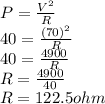
Physics, 14.06.2021 20:20 rebeckas0102
What is the resistance of a bulb of 40w connected in a line of 70v

Answers: 3


Other questions on the subject: Physics

Physics, 21.06.2019 23:00, desiwill01
We want to calculate the total metabolic heat generated by a singing canary taking into account heat transfer by radiation, convection and exhaling air. the air temperature is 20 oc, canary’s body internal and surface temperature is 33oc, external body surface convective heat transfer coefficient is 25.2 w/m2 .k, temperature difference between the inhaled and exhaled air is 4.3 oc, the ventilation rate is 0.74 cc of air per second, specific heat of air is 1.0066 kj/kg. k and density of air is 1.16 kg/m3 . assume the canary’s body to be a cylinder with 7 cm diameter and 9 cm length, and heat exchange is from the side as well as the top and bottom of cylinder. calculate 1) the net rate of heat lost by radiation, assuming heat gained by the bird through radiation from the surroundings is 11.5 w; 2) rate of heat transferred by convection to the surrounding air; 3) rate of heat transferred in the exhaling air without considering any internal evaporation; 4) total metabolic power.
Answers: 2

Physics, 21.06.2019 23:20, ElizabethF
Asmall, positively charged ball is moved close to a large, positively charged ball. which describes how the small ball likely responds when it is released? it will move toward the large ball because like charges repel. it will move toward the large ball because like charges attract. it will move away from the large ball because like charges repel. it will move away from the large ball because like charges attract.
Answers: 3

Physics, 22.06.2019 03:00, tylersabin72
1. a net force of 100 newton’s is applied to a wagon for 5 seconds. this causes the wagon to undergo a change in momentum of
Answers: 1

Physics, 22.06.2019 20:40, mathman783
Abasketball star covers 2.65 m horizontally in a jump to dunk the ball. his motion through space can be modeled precisely as that of a particle at his center of mass. his center of mass is at elevation 1.02 m when he leaves the floor. it reaches a maximum height of 1.90 m above the floor and is at elevation 0.910 m when he touches down again. (a) determine his time of flight (his "hang time"). (b) determine his horizontal velocity at the instant of takeoff. (c) determine his vertical velocity at the instant of takeoff. (d) determine his takeoff angle. (e) for comparison, determine the hang time of a whitetail deer making a jump with center-of-mass elevations yi = 1.20 m, ymax = 2.45 m, and yf = 0.750 m.
Answers: 1
You know the right answer?
What is the resistance of a bulb of 40w connected in a line of 70v...
Questions in other subjects:


Mathematics, 13.05.2021 17:20



Mathematics, 13.05.2021 17:20



Mathematics, 13.05.2021 17:20

English, 13.05.2021 17:20





